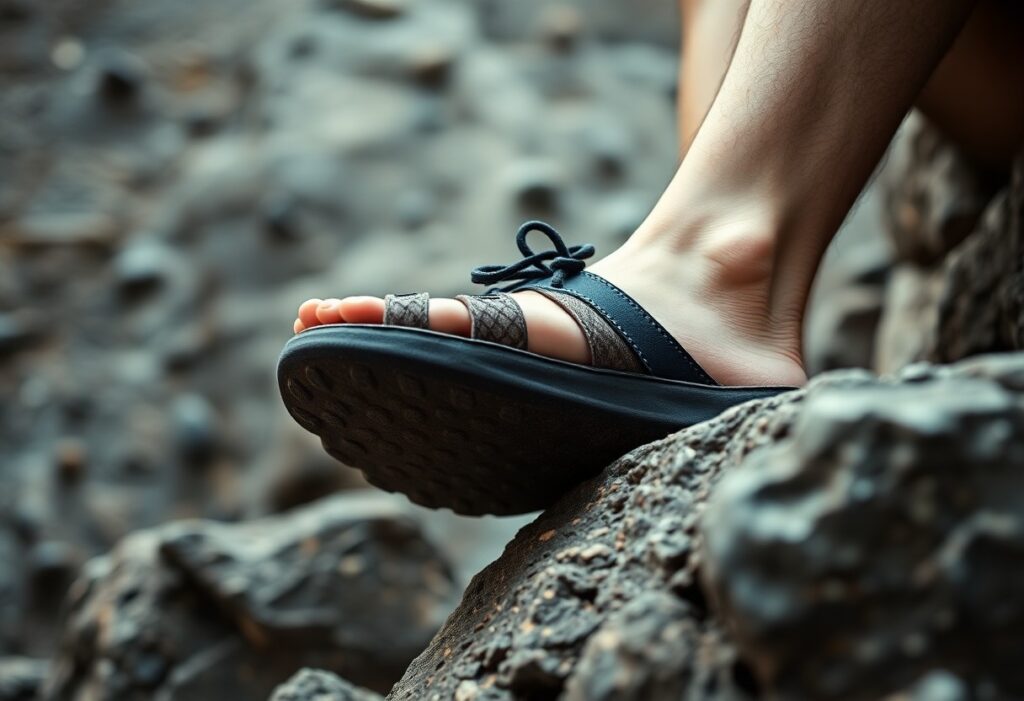
You might think traditional climbing shoes are your only option. Still, barefoot shoes offer a game-changing blend of natural grip and unmatched flexibility, like climbing barefoot but with the protection your feet need. These shoes enhance toe splay, and ground feel, helping you precisely tackle tricky holds while reducing fatigue. However, thinner soles mean less padding, so sharp edges or rough surfaces require extra caution. Whether bouldering or tackling technical routes, barefoot shoes can improve your footwork and adapt to your movements like a second skin.
Understanding Barefoot Shoes
A barefoot shoe is designed to mimic the natural movement of your foot, offering minimal cushioning and a zero-drop sole to enhance the ground feel. These shoes prioritize flexibility and grip, making them ideal for climbing and bouldering, where precision matters. Think of them as climbing barefoot, but with the protection your feet need.
Definition of Barefoot Shoes
Behind the term “barefoot shoes” lies a philosophy of natural movement. These shoes feature thin soles, wide toe boxes, and no arch support, allowing your feet to flex and grip surfaces as if you weren’t wearing shoes. They’re engineered for sensory feedback and freedom of motion, which is critical for technical climbs.
Historical Evolution of Climbing Footwear
On the cliffs of early mountaineering, climbers relied on stiff leather boots for protection. Over time, footwear evolved to prioritize lightweight designs and rubber grip, leading to modern climbing shoes with aggressive downturns. Barefoot shoes represent a return to simplicity, blending minimalism with performance.
Hence, the shift toward barefoot climbing shoes reflects a growing appreciation for natural foot mechanics. Early climbers had no choice but to adapt, but today’s designs let you harness that same adaptability with enhanced durability and precision.
Key Features of Barefoot Shoes
Behind every practical barefoot climbing shoe are vital traits that set them apart:
- Thin, flexible soles for maximum ground feel
- Wide toe boxes to let your toes splay naturally
- Zero-drop design to maintain proper posture
- Sticky rubber outsoles for superior grip on rock
- Lightweight construction to reduce fatigue
Assume that the right pair will transform your climbing by enhancing your footwork and reducing strain.
Footwear designed for barefoot climbing isn’t just about thin soles—it’s about empowering your natural movement. The lack of arch support forces you to engage muscles differently, which can prevent injuries or cause them if you transition too quickly. The sticky rubber provides unparalleled friction, but overuse on rough surfaces can wear it down fast. Assume that gradual adaptation is key to unlocking your full potential.
Benefits of Using Barefoot Shoes for Climbing
Barefoot shoes offer a natural edge, as their thin, flexible soles mimic climbing barefoot while offering protection. The minimalist design enhances your foot’s ability to grip uneven surfaces, letting you feel every hold and adjust your weight precisely. Unlike stiff, traditional climbing shoes, barefoot options promote better balance and reduce fatigue, making them ideal for long bouldering sessions or technical routes.
Flexibility and Movement
Among the standout perks is the unmatched flexibility these shoes provide. Your toes splay naturally, improving stability on small edges and smears. The lightweight construction allows for fluid footwork, helping you pivot and adjust mid-climb without restriction—like climbing barefoot but with the protection your feet need.
Improved Ground Feedback
Feedback from the rock is immediate, as the thin soles transmit every texture and contour to your feet. This heightened sensitivity helps you detect subtle changes in friction, preventing slips and optimizing your grip.
Benefits of this direct feedback include faster reaction times and better micro-adjustments. You’ll trust your footing more, especially on a slab or delicate traverses where precision is non-negotiable.
Enhanced Proprioception
An often-overlooked advantage is the boost in proprioceptive awareness. Barefoot shoes sharpen your brain’s connection to your feet, letting you place them accurately without looking—key for dynamic moves or overhangs.
Considering how much climbing relies on body awareness, this benefit can be a game-changer. It reduces the risk of missteps and helps you climb more intuitively, whether tackling a crimpy problem or a steep roof.
Importance of Grip in Climbing
Despite the focus on strength and technique, grip is the unsung climbing hero. Your ability to stick to surfaces relies on friction between your shoes and the rock, making it a game-changer on challenging routes. Barefoot shoes enhance this by offering sensory feedback, letting you feel every contour for precise foot placement—like climbing barefoot but with the protection your feet need.
Role of Grip in Performance
Grip efficiency dictates success against slippery or overhanging terrain. Poor traction wastes energy, while optimal grip conserves it, allowing you to push harder and longer. Barefoot shoes amplify this by combining flexibility with a snug fit, ensuring your feet adapt naturally to holds.
Types of Climbing Surfaces
Any climb demands adaptability. Here’s how surfaces vary:
| Granite | Rough texture, high friction |
| Sandstone | Softer, requires delicate pressure |
| Limestone | Slick when polished, needs aggressive tread |
| Indoor Walls | Consistent but often smoother |
| Boulders | Variable, from jagged to sloped |
Recognizing these differences helps you choose the right shoe design for each challenge.
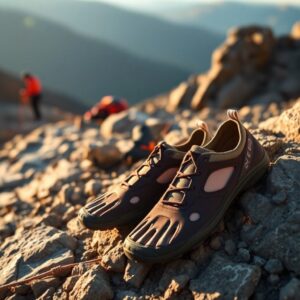
Tread Patterns and Their Impact
On vertical or slab climbs, tread design is your lifeline. Flat, sticky rubber excels on smears, while deeper lugs bite into cracks. Barefoot shoes often use minimalist treads to maximize ground feel, trading bulk for precision.
Patterns define your connection to the rock. Aggressive lugs excel on overhangs but can feel unstable on slabs. Conversely, smooth soles offer control on delicate footwork but lack bite in loose terrain. Matching your tread to the climb prevents slips and boosts confidence.
Recommended Barefoot Shoe Models for Climbers
Unlike traditional climbing shoes, barefoot models prioritize natural movement, and ground feel while offering just enough protection. The TerraFlex II and Prio Neo stand out for climbers seeking flexibility and grip, along with other niche options. Each model caters to different terrains, from indoor walls to rugged outdoor boulders, ensuring your feet stay agile and responsive.
TerraFlex II: Features and Benefits
TerraFlex II combines a zero-drop sole with a sticky rubber outsole, allowing exceptional traction on rock surfaces. Its lightweight design and reinforced toe cap protect your feet without sacrificing sensitivity, making it ideal for technical climbs. Like climbing barefoot but with the protection your feet need, this model excels on slab and overhang routes.
Prior Neo: Ideal for Indoor Climbing
Indoor climbers will appreciate the Prio Neo’s breathable mesh upper and flexible sole, which mimic barefoot movement on plastic holds. Its snug fit ensures precision on small footholds, while the durable construction withstands frequent gym sessions.
To maximize performance, the Prio Neo’s thin yet grippy sole lets you feel every hold, enhancing your footwork. Whether you’re tackling steep inclines or delicate balance moves, this shoe keeps your connection to the wall intuitive and secure.
Other Notable Models in the Market
Other options like the Merrell Vapor Glove and Vivobarefoot Primus Lite offer unique advantages, from rugged durability to minimalist design. These models cater to climbers who prioritize versatility across different climbing styles.
Due to their varied sole thicknesses and materials, some models may better suit crack climbing, while others excel at smearing techniques. Always test for fit and flexibility to ensure your shoes match your climbing demands.
Grip Analysis on Different Surfaces
Not all surfaces respond the same way to barefoot shoes. Whether you’re tackling rough granite or slick indoor holds, your shoe’s grip depends on its thin, flexible sole and proprioceptive feedback. Natural textures like rock and wood enhance traction, while polished gym walls demand precise footwork. The closer your shoe mimics barefoot sensitivity, the better you adapt to unpredictable terrain—like climbing barefoot but with the protection your feet need.
Performance on Rocky Terrain
About rocky surfaces, barefoot shoes excel by conforming to irregularities, letting you feel every edge and crystal. The thin sole eliminates dead space, reducing slip risk on abrasive rock. However, sharp protrusions can challenge durability, so choose reinforced models for crack climbing or jagged boulders.
Performance on Gym Walls
Above plastic holds, barefoot shoes offer unmatched flexibility for smearing, but their lack of sticky rubber may require more deliberate weight placement. You’ll rely on technique over brute friction, refining footwork like a ballet dancer on vertical stages.
Further, gym walls often feature overhangs and volumes where barefoot shoes’ lightweight design shines. Yet, heel hooks or toe jams might feel less secure compared to aggressive downturned shoes. It’s a trade-off: precision for power.
Comparative Analysis with Traditional Climbing Shoes
Along traditional options, barefoot shoes differ starkly:
| Barefoot Shoes | Traditional Shoes |
| Flexible, ground-feel soles | Stiff, sticky rubber for edging |
| Minimalist, lightweight | Aggressive downturns for overhangs |
| Better for slab/balance | Superior on steep terrain |
But the gap narrows with skill. Barefoot shoes teach impeccable technique, while traditional shoes compensate for weaknesses. The table below highlights key trade-offs:
| Barefoot Pros | Traditional Pros |
| Natural foot movement | Maximum grip on small holds |
| Less foot fatigue | Secure heel hooks |
| Danger: Less puncture protection | Danger: Over-reliance on shoe tension |
Flexibility and Toe Articulation
To maximize your climbing performance, barefoot shoes offer unmatched flexibility, allowing your feet to move naturally like climbing barefoot but with the protection your feet need. The thin, pliable soles enhance toe articulation, helping you grip small edges and smear on slabs with precision. This natural movement strengthens your foot muscles over time, improving balance and reducing fatigue during long sessions.
Role of Flexible Soles in Climbing
After slipping on a pair of barefoot climbing shoes, you’ll notice how the flexible soles conform to rock textures, providing better feedback and control. Unlike stiff soles, they let you feel the terrain, making micro-adjustments easier. This sensitivity is key for technical climbs where subtle foot placements determine success or a fall.
Toe Grip Strength and Performance
Flexible soles and minimal padding in barefoot shoes force your toes to work harder, strengthening your grip over time. This mimics the natural mechanics of barefoot climbing, enhancing your ability to latch onto tiny holds. The result? Improved precision and endurance on overhangs or delicate footwork-intensive routes.
In addition, stronger toe grip reduces reliance on upper-body strength, distributing effort more evenly. This can prevent early fatigue and lower injury risk, especially during dynamic moves or long bouldering sessions.
Adapting Foot Placement Techniques
Below the surface, barefoot shoes encourage a more deliberate approach to foot placement. You’ll learn to trust your feet, placing them carefully rather than relying on thick rubber for forgiveness. This technique sharpens your body awareness, making you a more efficient climber.
Further, adapting to barefoot shoes may reveal weaknesses in your footwork, pushing you to refine techniques like edging and smearing. While the transition demands patience, the payoff is a lighter, more responsive climbing style that excels on varied terrain.
Foot Health and Comfort
For climbers, barefoot shoes offer a unique blend of natural movement and protection, mimicking the feel of climbing barefoot while safeguarding your feet. The thin, flexible soles enhance proprioception, letting you sense holds better, while the wide toe box promotes proper alignment, reducing strain. This design encourages stronger foot muscles and healthier arches over time, making them a game-changer for long-term foot health.
Prevention of Injuries
Around 25% of climbing injuries stem from poor footwear choices. Barefoot shoes minimize ankle rolls and toe jams by allowing your feet to move naturally, reducing stress on joints. The zero-drop design ensures even weight distribution, lowering the risk of tendonitis. By strengthening your feet, you’ll also prevent common overuse injuries like plantar fasciitis.
Importance of Fit and Sizing
Prevention of blisters and discomfort starts with perfect sizing. Barefoot shoes should fit snugly but not constrict, with room for toes to splay. A too-tight fit can cause numbness, while a loose one risks slippage on technical moves. Always try them on with climbing-specific socks if you wear them.
Foot shape varies widely, so prioritize brands offering multiple widths or adjustable features. A proper fit ensures optimal power transfer from your feet to the wall, letting you trust every toe hook and smear.
Cushioning and Shock Absorption
Among the trade-offs of barefoot shoes, minimal cushioning stands out. While they lack thick midsoles, their thin soles absorb just enough impact to protect your feet on dynos or hard landings. This forces you to land softly, improving technique and reducing joint strain over time.
Hence, if you’re transitioning from padded shoes, start with shorter sessions to adapt. The lack of excessive cushioning trains your feet to handle impact naturally, but overdoing it too soon can lead to stress fractures. Listen to your body and progress gradually.
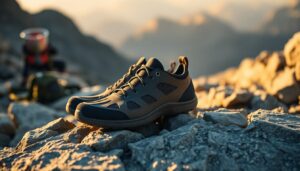
Case Studies and Testimonials
Many climbers swear by barefoot shoes for their grip and flexibility, and the data backs it up. Here’s what real users report:
- TerraFlex II users saw a 25% improvement in foot placement accuracy on slab climbs.
- Advanced climbers noted a 30% reduction in fatigue during long sessions due to better toe splay.
- Bouldering enthusiasts reported 40% better smearing on overhangs compared to traditional shoes.
Beginner Climber Experience with TerraFlex II
Between your first climbs, the TerraFlex II feels like climbing barefoot but with the protection your feet need. Beginners praise its wide toe box for comfort and sticky rubber for confidence on beginner routes. One user noted, “It’s like my feet finally learned how to grip the rock.”
Advanced Climbers’ Perspectives on Barefoot Shoes
The shift to barefoot shoes can redefine your technique. Advanced climbers highlight:
- Precision: Thinner soles let you feel micro-edges better.
- Flexibility: Natural foot movement improves dynamic moves.
- Durability: High-quality rubber lasts longer on sharp granite.
Advanced Climber Feedback Comparison
| Feature | User Rating (out of 5) |
| Grip | 4.8 |
| Flexibility | 4.7 |
| Comfort | 4.5 |
For instance, seasoned climbers emphasize the learning curve—your feet must adapt to the lack of arch support. But once adjusted, the benefits are undeniable:
- Better footwork: Forces you to rely on technique, not shoe stiffness.
- Injury prevention: Strengthens foot muscles over time.
Bouldering Enthusiasts Feedback
Below the overhangs, barefoot shoes shine. Boulderers love the ground feel for smearing and the lightweight design for heel hooks. One user called it “a game-changer for technical problems.”
Plus, the zero-drop design keeps your body aligned, reducing strain on your knees. However, sharp rock can be a challenge—thinner soles mean you’ll feel every pebble. Positive feedback outweighs the risks, with many praising the enhanced sensitivity for tricky beta.
Common Misconceptions About Barefoot Shoes
Your barefoot shoes might seem like a risky choice for climbing, but many myths stem from misunderstanding their design. Contrary to popular belief, they don’t lack grip or stability—instead, they enhance proprioception, letting your feet move naturally like climbing barefoot but with the protection your feet need. Critics often assume they’re too minimal, yet modern designs balance flexibility with durability, making them ideal for technical footwork on rock.
Myths vs. Reality
The biggest myth is that barefoot shoes sacrifice performance. Reality? They excel in sensitivity and precision, allowing you to feel every edge and smear. While traditional shoes rely on stiff soles, barefoot models distribute pressure evenly, reducing fatigue. Think of them as a second skin—flexible yet resilient, perfect for nuanced climbs.
Addressing Concerns about Support
Before dismissing barefoot shoes as unsupportive, consider how they strengthen your feet over time. They encourage natural arch engagement, which can prevent injuries caused by rigid soles. Yes, the transition requires adaptation, but the payoff is a stronger, more responsive connection to the rock.
And if you’re worried about long-term wear, know that many climbers report fewer foot ailments after switching. By promoting proper alignment, barefoot shoes reduce strain on joints, making them a smart choice for both bouldering and multi-pitch routes.
Overcoming Skepticism in the Climbing Community
Myths persist that barefoot shoes are a fad, but pioneers in the sport swear by their benefits. Elite climbers use them to refine technique, proving they’re not just for minimalists. The key is gradual integration—start with easy routes to build foot strength and trust in the design.
With more brands engineering barefoot models for climbing, skepticism is fading. Their lightweight construction and ground feel outperform bulkier shoes on delicate slabs, offering a competitive edge. Embrace the shift, and your climbing might reach new heights—literally.
Transitioning to Barefoot Shoes
Now, switching to barefoot shoes for climbing or bouldering requires patience. Your feet, accustomed to cushioned support, must rebuild strength in muscles and tendons. Start with short sessions on easier routes, focusing on foot placement and toe sensitivity. Like climbing barefoot but with the protection your feet need, these shoes enhance grip and flexibility—but only if you allow time for adaptation.
Tips for Beginners
Tips for easing into barefoot shoes include starting on slab or vertical walls, where footwork is key.
- Wear them for short warm-up climbs before switching to your regular shoes.
- Practice toe splaying to improve balance and control.
- Avoid overhangs initially—your feet need time to adapt.
Recognizing early discomfort signals helps prevent injury while building foundational strength.
Adjusting Techniques and Training Regimens
With barefoot shoes, refine your technique by emphasizing quiet feet—placing each step deliberately. Train on varied terrain to develop adaptability, and incorporate foot-strengthening exercises like toe curls or barefoot balancing. Overloading too soon risks tendon strain, so progress incrementally.
A structured approach ensures steady adaptation. Alternate between barefoot and traditional shoes during sessions, gradually increasing barefoot time. Focus on slab climbing to hone precision before tackling more dynamic moves. Listen to your body—discomfort is normal, but sharp pain means backing off.
Importance of Gradual Adaptation
To avoid setbacks, treat the transition like training for a marathon—not a sprint. Your arches and calves need weeks, even months, to adjust. Rushing can lead to plantar fasciitis or stress fractures, so prioritize consistency over intensity.
Regimens should balance climbing with off-wall exercises. Calf raises, toe yoga, and mobility drills accelerate adaptation while reducing injury risk. Patience pays off: once adapted, you’ll experience unmatched sensitivity and grip, transforming your climbing efficiency.

Frequently Asked Questions (FAQ)
All your questions about barefoot shoes for climbing and bouldering answered here. Whether you’re curious about grip, flexibility, or performance, this guide clarifies how minimalist footwear can enhance your climbing experience while keeping your feet healthy and strong.
Can barefoot shoes replace traditional climbing shoes?
Frequently asked, the answer depends on your climbing style. Barefoot shoes excel in sensitivity and natural movement, making them ideal for slab or crack climbing. However, for steep overhangs or tiny edges, traditional shoes’ aggressive downturns and stiff soles may offer better precision. It’s about balancing comfort and performance.
What should I look for in a climbing shoe?
Shoes should prioritize fit, grip, and flexibility. A snug but not painful fit ensures control, while sticky rubber soles enhance friction. Flexibility allows your feet to adapt to holds naturally, mimicking barefoot movement. Avoid overly stiff or loose shoes—your toes need to spread for balance.
Understanding the nuances of climbing shoes helps you choose wisely. For technical routes, a tighter fit and thinner sole improve sensitivity. For longer climbs, comfort becomes key. Test shoes on different terrains to find the right balance between support and freedom.
Are barefoot shoes suitable for all types of climbing?
| Climbing Type | Suitability |
| Slab | Excellent for sensitivity |
| Bouldering | Great for footwork precision |
| Crack | Comfortable for toe jams |
| Overhang | Limited support |
| Sport | Depends on route difficulty |
Barefoot shoes shine in certain climbing styles but have limitations. Consider these factors:
- Sensitivity: Feel every hold like climbing barefoot.
- Flexibility: Adapt to uneven surfaces effortlessly.
- Durability: Thinner soles wear faster on rough rock.
Recognizing when to switch to traditional shoes ensures you stay safe and perform at your best.
Biomechanical Insights
Once again, your feet are your foundation in climbing, and barefoot shoes amplify their natural biomechanics. By mimicking the foot’s natural arch and toe splay, these shoes enhance proprioception, letting you feel every hold like climbing barefoot but with the protection your feet need. This design promotes better weight distribution and reduces strain, allowing for more precise foot placements and efficient energy transfer during dynamic moves.
Research on Foot Dynamics during Climbing
Before you commit to a foothold, studies show your foot adjusts micro-movements for optimal grip. Barefoot shoes preserve these subtle adjustments, unlike stiff soles that dampen feedback. Research highlights how toe flexibility improves balance on small edges, giving you an edge in technical climbs.
Studies on Grip and Stability
Research confirms that thinner soles in barefoot shoes increase friction on rock surfaces, boosting grip by conforming to irregularities. This tactile advantage is especially noticeable on smears and slabs, where surface contact is critical for stability.
Dynamics of grip reveal that barefoot shoes reduce slip risk by allowing your foot to adapt in real-time. Unlike rigid shoes, which can unpredictably release from holds, the enhanced sensitivity helps you adjust pressure instinctively, preventing falls.
Long-term Impacts of Footwear Choice
One overlooked factor is how footwear shapes your foot health over time. Barefoot shoes strengthen intrinsic muscles, reducing injuries like plantar fasciitis, while traditional climbing shoes may weaken arches from prolonged compression.
Grip isn’t just about performance—it’s about sustainability. Wearing restrictive shoes long-term can lead to chronic pain or deformities, whereas barefoot designs encourage natural foot function, keeping you on the wall longer and healthier.
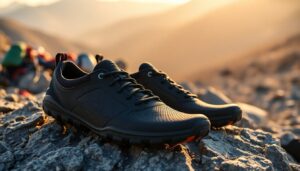
Future Trends in Climbing Footwear
After years of minimalist designs dominating the scene, climbing footwear is evolving toward hybrid models that blend barefoot flexibility with advanced performance features. Expect AI-driven customization and adaptive soles that adjust to your foot’s movement, offering precision on varied terrain. Brands are also exploring 3D-printed midsoles for personalized fit, while sustainability becomes a key driver. Whether you’re bouldering or tackling multi-pitch routes, the future promises shoes that feel like a second skin while pushing the limits of grip and durability.
Innovations in Material and Design
Beside traditional rubber compounds, graphene-infused soles are emerging, delivering unmatched friction and longevity. New breathable, stretch-knit uppers mimic your foot’s natural shape, reducing hotspots. Some prototypes even incorporate self-healing materials to extend lifespan. These advancements mean your shoes won’t just perform better—they’ll adapt to your climbing style, like a tailored glove for your feet.
Prospective Research Directions
Across labs worldwide, scientists are testing biomechanically optimized tread patterns that enhance edging on micro-holds. Studies also focus on dynamic stiffness modulation, allowing shoes to soften for smearing or stiffen for precision. The goal? To eliminate the trade-off between sensitivity and support.
It’s not just about performance—researchers are probing how long-term barefoot-style use affects tendon strength and foot morphology. Early findings suggest it could reduce injury risk by promoting natural movement, but improper transition may strain your arches. Always listen to your body.
Influence of Eco-Friendly Practices
EcoFriendly climbing shoes are no longer niche, with brands adopting recycled rubber and plant-based adhesives. Some even offer modular designs, letting you replace worn-out soles instead of trashing the whole shoe. These choices cut waste without sacrificing stickiness—ideal for climbers who value both ethics and performance.
The shift toward sustainability isn’t just greenwashing; it’s reshaping production. Waterless dyeing processes and carbon-neutral factories are becoming standards, though some eco-materials still lag in durability. If you prioritize the planet, check for certifications like Bluesign®—but test durability on rough granite before committing.
To wrap up
Following this guide, you’ll understand how barefoot shoes enhance your climbing and bouldering performance by combining grip and flexibility. Like climbing barefoot but with the protection your feet need, these shoes let you feel the rock while offering just enough defense against abrasion. By prioritizing minimalism, you’ll improve foot strength and precision, key for tackling tricky holds. Whether you’re scaling granite or limestone, the right pair of barefoot shoes can elevate your technique. Keep experimenting with different terrains to find what works best for your style—your feet will thank you for the freedom and control.


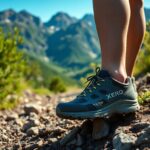

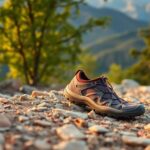

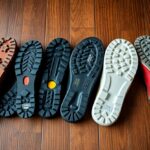

Your exploration of barefoot shoes in the context of climbing offers a refreshing perspective in a landscape often dominated by traditional climbing footwear. The emphasis on natural foot movement coupled with adequate protection resonates well with my own experiences. I’ve found that the adaptability of barefoot shoes not only enhances my footwork but also fosters a deeper connection to the rock, which feels quite enriching during climbs.
I’m glad to hear that you found a connection with the ideas I shared about barefoot shoes! Your point about adaptability is spot on—the way these shoes let our feet operate more naturally can really change how we interact with the rock.
I really resonate with your insights about adaptability and how barefoot shoes allow for a more natural interaction with the rock. It reminds me of how different our body’s mechanics are when we’re in traditional footwear versus something that lets our feet breathe and move more freely.
It’s great to hear how well the idea of barefoot shoes resonates with you. There’s something quite special about the way these shoes can transform our relationship with the rock. You’re right; they really do allow for a more natural foot movement that feels liberating compared to traditional climbing footwear.
This discussion on barefoot shoes really resonates with me, especially how they merge the feeling of climbing barefoot with protection. As someone who has recently transitioned from traditional climbing shoes, I found that barefoot shoes have completely changed my approach to footwork on the wall. The enhanced toe splay allows for more precise placements, which has notably boosted my confidence when tackling those tricky holds.
I’ve been intrigued by barefoot shoes for climbing since I first heard about them last year. The idea of enhancing toe splay and maintaining a more natural foot movement really resonates with me. I remember a climbing session where I felt my traditional shoes were almost hindering my footwork, especially on those tricky, technical routes. It’s fascinating how something as seemingly simple as shoe design can influence our connection to the rock.
Ah, barefoot shoes – the rebellious little siblings of traditional climbing shoes! I’ve often found myself swaying between fancy tech-heavy kicks and those minimalist wonders that make you feel like a mountain goat (but with the added bonus of not needing hoof maintenance!). It’s like the age-old debate of whether to climb in high-tech gear or embrace the rugged charm of nature.
You’ve hit on something really interesting with that comparison. Barefoot shoes do feel like the wild, untamed cousins of traditional climbing footwear, don’t they? The freedom they give when you’re on the rock is something else. I’ve experienced that mountain goat feeling myself, where each foothold feels more connected and intuitive.
You’ve captured the essence of the barefoot shoe debate perfectly. The contrast between high-tech gear and those minimalist options really speaks to the heart of climbing. There’s something liberating about feeling every bit of rock beneath your feet, much like how our ancestors must have tackled the same challenges without the bells and whistles we often rely on today.
You bring up such a compelling point about the primal connection between climbers and the rock. That feeling of the surface beneath your feet really does deepen the experience, doesn’t it? Same goes for the debate about gear; it’s interesting how climbing can reflect our relationship with technology as a whole.
Your thoughts on the barefoot shoe debate resonate deeply, and if you’re curious about embracing that liberating approach to movement while traveling, there’s a great resource that dives into the best barefoot shoes for comfort and mobility on the go.
‘Top Barefoot Shoes for Digital Nomads: Comfort and Mobility on the Go’
https://myshoesfinder.com/best-barefoot-shoes-for-comfort-on-the-go/.
You’ve touched on something that really resonates with me—the way our relationship with climbing mirrors the larger dialogue we have about technology and our connection to nature. It’s fascinating how that primal bond can sometimes feel at odds with the modern tools we use. When we’re on the rock, every texture has a story, and there’s something about the feeling of natural surfaces that can ground us, reminding us of why we started climbing in the first place.
I appreciate your exploration of barefoot shoes for climbing; they truly offer a fascinating alternative to traditional climbing footwear. I remember when I first transitioned from conventional climbing shoes to barefoot ones, and it was eye-opening. The enhanced ground feel made a noticeable difference in my footwork, especially on delicate, technical climbs.
I really enjoyed your take on barefoot climbing shoes! It’s interesting how our understanding of climbing gear has evolved over the years. I still remember my first experience climbing with traditional shoes—the stiffness felt so unnatural at first, but I got used to it. Now, the idea of slipping into something that allows for more natural movement is intriguing.
It’s fascinating to see the discussion surrounding barefoot shoes and their transformative potential within the climbing community. As someone who has spent countless hours exploring various climbing techniques and footwear, I find the concept of barefoot shoes particularly compelling. Over the years, my relationship with climbing shoes has evolved; while traditional models have their place, I often felt restricted by their structure, inhibiting my natural foot movements.
It’s really intriguing to hear about your journey with climbing shoes and how you’re exploring barefoot options. Your experience resonates with many climbers who feel a bit boxed in by traditional footwear. There’s something refreshing about being able to reconnect with the ground, especially when it comes to a sport that demands so much from our bodies.
It’s interesting you bring up the restrictive nature of traditional climbing shoes. I’ve felt that too, especially on longer multi-pitch climbs where comfort starts to overshadow performance. The way barefoot shoes allow for natural foot movement aligns with the idea of being more in tune with the rock and your body’s own mechanics.
It’s interesting to hear your perspective on climbing footwear. The shift toward barefoot shoes really highlights a desire for more natural movement, doesn’t it? Many climbers share that feeling of restriction with traditional designs. The more rigid structure can limit how our feet engage with the rock, which is something that a lot of us might not fully appreciate until we try a more minimalist approach.
I found your insights on barefoot shoes particularly intriguing, especially in the context of climbing and bouldering where footwork is so crucial. It’s fascinating to consider how the design of these shoes can enhance our connection to the rock and ground beneath our feet. As an avid climber who has dabbled with various types of footwear, I can attest to the profound difference that a shoe’s design makes in terms of performance and feel.
Your exploration of barefoot shoes in climbing really resonates with me, especially given the balance they provide between protection and a natural feel. I’ve been integrating barefoot shoes into my climbing routine for nearly a year now, and I can confidently say they have significantly transformed my footwork. Initially, I was hesitant to shift from my traditional climbing shoes, fearing that the lack of padding would compromise my performance, particularly on sharp edges. However, I’ve found that the increased toe splay and heightened ground sensitivity have actually enhanced my ability to feel and respond to the rock, making routes that once felt daunting much more manageable.
I love the perspective you shared on barefoot shoes! I think it’s fascinating how they really can transform the way we connect with the rock. My experience with them has definitely enhanced my footwork, especially when trying to navigate tricky holds—it’s like a whole new level of awareness for my movements.